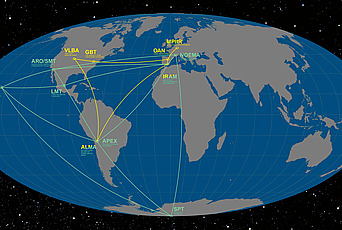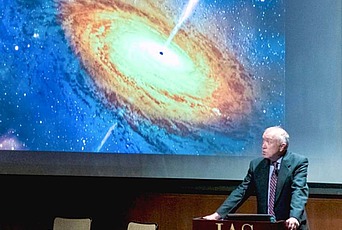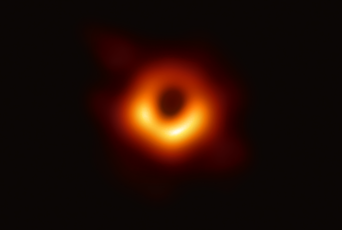Research Team Discovers Path to Razor-Sharp Black Hole Images
Press Contact

Last April, the Event Horizon Telescope (EHT) sparked international excitement when it unveiled the first image of a black hole. Today, a team of researchers have published new calculations that predict a striking and intricate substructure within black hole images from extreme gravitational light bending.
"The image of a black hole actually contains a nested series of rings," explains Michael Johnson of the Center for Astrophysics | Harvard and Smithsonian (CfA). "Each successive ring has about the same diameter but becomes increasingly sharper because its light orbited the black hole more times before reaching the observer. With the current EHT image, we've caught just a glimpse of the full complexity that should emerge in the image of any black hole."
Because black holes trap any photons that cross their event horizon, they cast a shadow on their bright surrounding emission from hot infalling gas. A "photon ring" encircles this shadow, produced from light that is concentrated by the strong gravity near the black hole. This photon ring carries the fingerprint of the black hole—its size and shape encode the mass and rotation or "spin" of the black hole. With the EHT images, black hole researchers have a new tool to study these extraordinary objects.
"This is an extremely exciting time to be thinking about the physics of black holes," says Daniel Kapec, Member in the School of Natural Sciences at the Institute for Advanced Study. "Einstein’s theory of general relativity makes a number of striking predictions for the types of observations that are finally coming within reach, and I think we can look forward to lots of advances in the coming years. As a theorist, I find the rapid convergence between theory and experiment especially rewarding, and I hope we can continue to isolate and observe more universal predictions of general relativity as these experiments become more sensitive."
The research team included observational astronomers, theoretical physicists, and astrophysicists.
"Bringing together experts from different fields enabled us to really connect a theoretical understanding of the photon ring to what is possible with observation," notes George Wong, a physics graduate student at the University of Illinois at Urbana-Champaign. Wong developed software to produce simulated black hole images at higher resolutions than had previously been computed and to decompose these into the predicted series of sub-images. "What started as classic pencil-and-paper calculations prompted us to push our simulations to new limits."
The researchers also found that the black hole's image substructure creates new possibilities to observe black holes. "What really surprised us was that while the nested subrings are almost imperceptible to the naked eye on images—even perfect images—they are strong and clear signals for arrays of telescopes called interferometers," says Johnson. "While capturing black hole images normally requires many distributed telescopes, the subrings are perfect to study using only two telescopes that are very far apart. Adding one space telescope to the EHT would be enough."
"Black hole physics has always been a beautiful subject with deep theoretical implications, but now it has also become an experimental science," says Alex Lupsasca from the Harvard Society of Fellows. "As a theorist, I am delighted to finally glean real data about these objects that we've been abstractly thinking about for so long."
In addition to those listed above, the research team included Andrew Strominger, Shahar Hadar, Ramesh Narayan, Andrew Chael, Charles Gammie, Peter Galison, Daniel Palumbo, Sheperd Doeleman, Lindy Blackburn, Maciek Wielgus, Dominic Pesce, Joseph Farah, and James Moran.
The results were published in Science Advances and are available here.
This research was supported by grants from the National Science Foundation, the United States Department of Energy, the Gordon and Betty Moore Foundation, the John Templeton Foundation, the Jacob Goldfield Foundation, and NASA.
A release from the Center for Astrophysics | Harvard & Smithsonian is available here.
About the Institute
The Institute for Advanced Study is one of the world's foremost centers for theoretical research and intellectual inquiry. Located in Princeton, N.J., the IAS is dedicated to independent study across the sciences and humanities. Founded in 1930 with the motto "Truth and Beauty," the Institute is devoted to advancing the frontiers of knowledge without concern for immediate application. From founding IAS Professor Albert Einstein to the foremost thinkers of today, the IAS enables bold, nonconformist, field-leading research that provides long-term utility and new technologies, leading to innovation and enrichment of society in unexpected ways.
Each year, the Institute welcomes more than 200 of the world's most promising researchers and scholars who are selected and mentored by a permanent Faculty, each of whom are preeminent leaders in their fields. Comprised of four Schools—Historical Studies, Mathematics, Natural Sciences, and Social Science—IAS has produced an astounding record of introducing new understanding and is responsible for undeniable progress across disciplines and generations, from the development of one of the first stored-program computers to the establishment of art history as a discipline in the United States. Among its present and past Faculty and Members are 34 Nobel Laureates, 42 of the 60 Fields Medalists, and 19 of the 22 Abel Prize Laureates, as well as many MacArthur Fellows and Wolf Prize winners.


